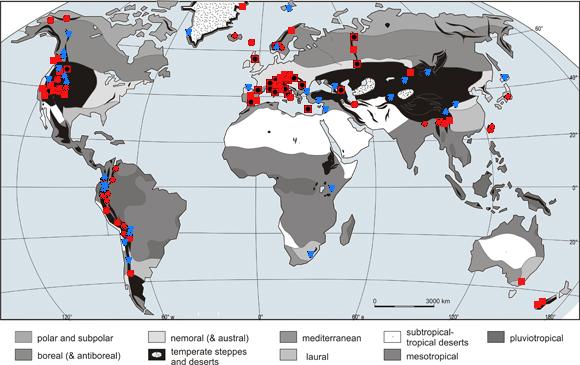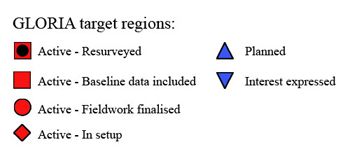Global distribution of GLORIA sites
The main mountain ranges, especially the most extensive systems and their position within the continents are important for site selection.
Asia and the Americas are of particular importance.
In Asia, the large mountain ranges are in the interior and have a highly continental climate.
The Americas present a unique case with their almost uninterrupted north-south chains of mountain ranges
extending
from Alaska to Patagonia.
The vegetation zones coverage
Target regions should be distributed across all the major vegetation zones, or zonobiomes (sensu Walter 1985; Richter 2001),
- from tropical to polar latitudes to cover tropical mountains with a diurnal humid climate (zonobiome I);
- tropical mountains with an annual temperature and precipitation periodicity (zonobiome II);
- high desert areas of the tropics and subtropics (zonobiome III);
- Mediterranean mountains (zonobiome IV);
- mountains in the warm-temperate humid vegetation zone (zonobiome V);
- temperate mountains (zonobiome VI); temperate dry mountains (zonobiome VII);
- boreal mountains (zonobiome VIII);
- and polar/arctic/antarctic mountains (zonobiome IX).
Further, major transition zones such as subpolar, or transitions from zonobiome I to zonobiome II, may be considered.
Currently, most sites are concentrated in Europe, where only mediterranean, temperate, boreal, sub-polar mountains are found.


The role of global circulation systems
Regional and large-scale climate regimes largely account for plant diversity and vegetation patterns (Richter 2000) and cause different climate changes.
For the arctic region, strong warming (up to 8 K), especially in summer is predicted, with probable changes of precipitation patterns.
At mid-latitudes, warming, although less pronounced than in the arctic, and precipitation changes are
predicted.
In the arid subtropics and in the tropics, according to the ECHAM4 circulation model (Roeckner et al.
1996), changes
in precipitation are likely to be more important than warming (< 2 K).
Deviating major circulation systems such as those caused by the large landmasses of the northern hemisphere are to be considered, e.g. monsoon-influenced regions. Of importance is to include the southern hemisphere outside of the tropics, because other climate change dynamics are expected than in northern hemisphere.

